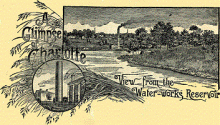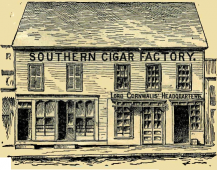You are here
Historical and Descriptive
This information was first published in 1888:
HISTORICAL AND DESCRIPTIVE
MIDWAY between New York and New Orleans, on the great Piedmont Air Line route, is located the city to which these pages refer. Charlotte, really, and truly, the Queen City of the Old North State, and the county seat of Mecklenburg, the banner county. These are not empty claims, and this writer would not make them his boast unless he felt that, without straining a single point, he could carry his readers with him. Charlotte is not only the busiest, the most progressive and the most enterprising city in North Carolina, but she is destined to assume the position, in the early future, of the most important commercial and manufacturing center between Atlanta and Baltimore. With the opportunities which are given her she would indeed make a dismal failure should she fail to verify this prediction. We do not fear a failure, however. Ten years ago Charlotte was merely a thrifty town, but to-day she is a small, but bustling city, with the advantages of water works; electric lights, arc and incandescent; gas lights; sewerage; street cars; telephone; electric fire alarm; paid fire department; free postal delivery; macadamized streets; brick and stone sidewalks, etc. A city that can acquire all of these internal improvements within the limited space of ten years, increase its population thirty per cent, pay off its accumulated debt and reduce its rate of taxation at the same time, surely has a future before it. Such is the record of Charlotte.
CHARLOTTE, the county seat of Mecklenburg, is located in the great Piedmont belt, north of the 35th parallel of latitude, and almost midway between the Atlantic coast and the Appalatian [sic] range of mountains. It is the hub of the great Richmond and Danville railroad system, and the most important railroad center in the Slate. From no point of the compass can the city be entered without crossing two or more railroad tracks. From the south comes in the Charlotte, Columbia & Augusta Division of the R. & D., and the Air Line division of the same company; from the west comes in the Western North Carolina and the Atlantic, Tennessee & Ohio division of the R. & D., and from the North the Virginia Midland and North Carolina divisions; from the east comes the Seaboard Air Line, from Baltimore and Norfolk, via Raleigh, and from Wilmington; and from the West comes the western division of the Carolina Central road. This shows Charlotte to be the centre of six railroad lines, but three more are projected and will, in all probability, be built within the next two years. One is a road from Charlotte to Weldon, the second is a branch road of the 3 C's Company from Lancaster to Charlotte, and the third is a branch road from Laurens, S. C. All of these proposed roads are regarded as certainties, but even if they are not built, the roads already running into Charlotte are sufficient to show the importance of the rail connections of the city.
Charlotte is an historical city; but as our field is the progressive present and the prospective future rather than the eventful past, we can dwell but slightly upon things historical. Mecklenburg was formed in 1762, was named in honor of Princess Charlotte of Mecklenburg, and was originally settled by Scotch-Irish. It was the citizens of this county who drafted and signed the first Declaration of Independence on May 20, 1775. Several historical revolutionary battles were fought on Mecklenburg soil. Lord Cornwallis, with his main army, was encamped in Charlotte from September 26 to October 14, 1780, and Queen's College, the first educational institution of the kind established in the United States, was built in Charlotte. Brick imported from England were used in its construction. The college was located on the ground now occupied by the residence of Mr. A. B. Davidson, and last fall some of the foundation brick were dug up and laid in the foundation of the new building of the Y. M. C. A. Cornwallis' headquarters remained standing, near the Springs corner, in this city, until the fall of 1886, when the old house was torn down to give way to the march of improvement. A sketch of the building, made from a photograph, is given on another page. This much we mention incidental to the history of the town and county; and now we pass on to the . . .
Sketches of Charlotte, the Queen City of the Old North State and Mecklenburg, the Banner County. Charlotte, NC: Charlotte Chamber of Commerce, 1888.

